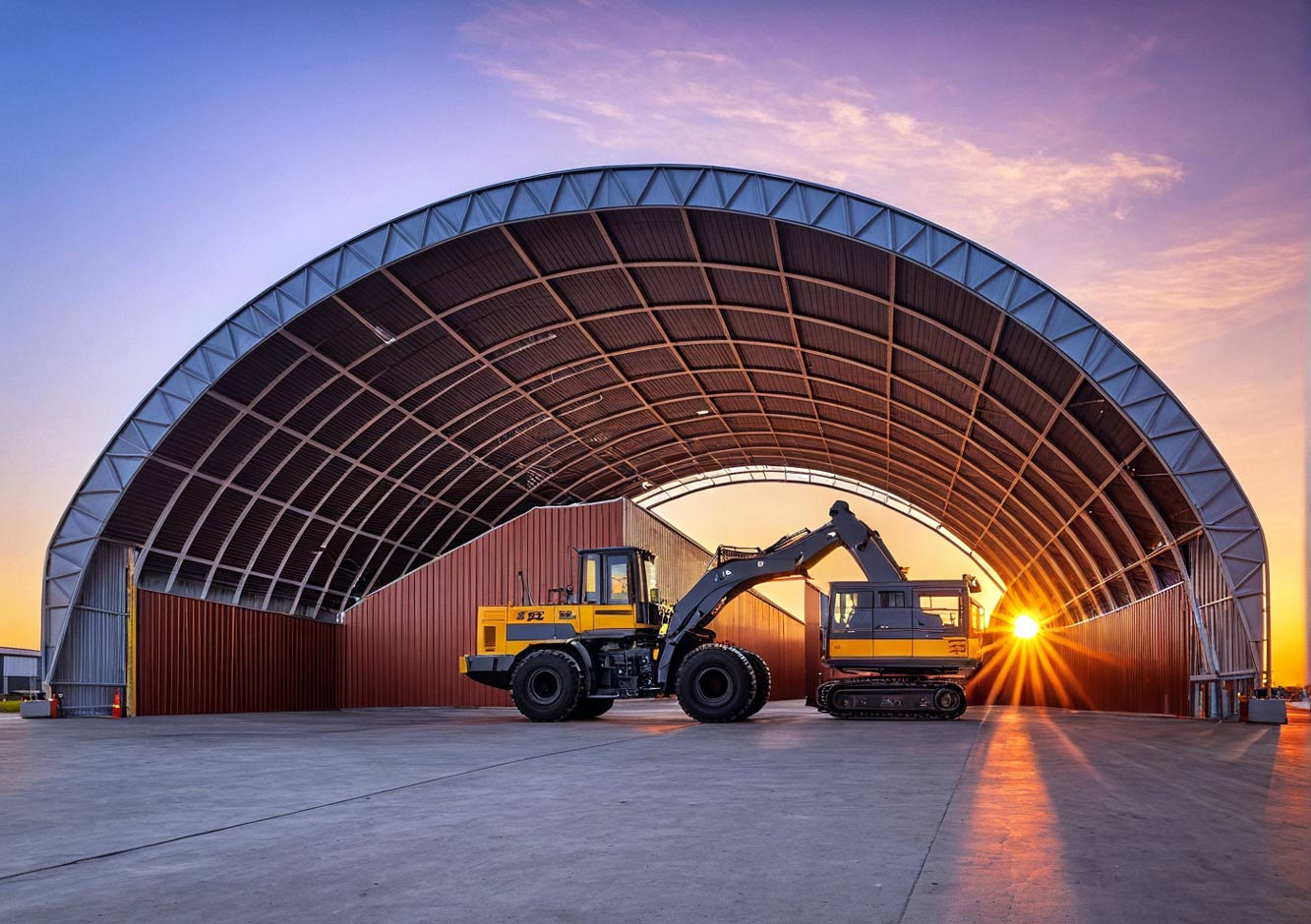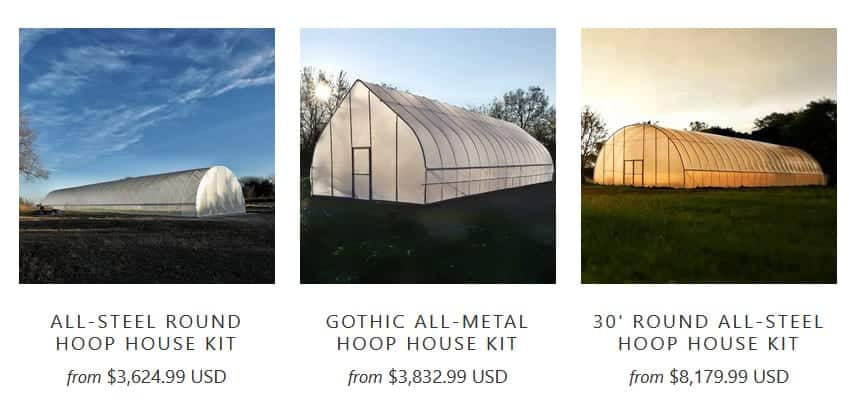If you’re looking for an affordable, easy-to-build metal structure, a hoop building may be an excellent option for you. Their rounded design makes them similar to a Quonset hut, but rather than being an all-metal structure, hoop buildings use fabric to cover and protect the interior.
Hoop buildings have many advantages, and they are generally less expensive to construct than other building types. Let’s take a closer look at what these buildings are, how they are used and how much they cost.
What are Hoop Buildings?

Hoop buildings are fabric tension buildings and are sometimes referred to as tensile structures.
A typical hoop building consists of a heavy-duty metal frame and UV-resistant fabric covering that’s stretched tightly over the frame.
Usually, the fabric is made from canvas, high-density polyethylene or some other heavy-duty fabric.
As the name suggests, the building has a hooped roof. Because the structure has minimal components, they’re typically portable and have many uses. They are structurally similar to quonset huts.
What are Hoop Barns Used For?
Hoop buildings can be used for a variety of purposes, from agricultural to storage and even industrial use.
Many agricultural operations prefer hoop buildings for livestock because of the superior air circulation. Adequate air circulation is crucial for livestock health. The rounded, hoop design of the building promotes good air flow. You can find hoop buildings that are designed for specific types of livestock, including cattle, sheep and swine. Dairy buildings are another popular use for this type of structure.
Hoop barns can also be used to store feed, agricultural equipment and other related items.
While agriculture is the most popular application for these structures, they can also be used for storage facilities. Storage Canopy, for example, offers hoop structures that are designed to serve as a roof. In addition, they provide coverage for areas between shipping containers or other storage facilities, making it easier and more comfortable to access these areas.
Other uses for hoop buildings include:
- Hay storage
- Riding arenas
- Farm garages
- Construction shelter
- Commodity sheds
- Sand or salt sheds
Hoop barns are versatile and easy to construct, making them ideal for a wide range of applications.
Hoop Buildings Prices
Hoop buildings are a concept many homeowners and businesses are turning to for storage, livestock, farming, multi-use and even farm garages. Size will be a major factor in building price, and hoop buildings often have widths between 24’ and 140’.
Prices can fluctuate, but at the time of writing this, you can expect to pay:
- $3.43 per square foot for a single truss model
- $4.81 per square foot for a double truss model
These are basic prices for the hoop kit only. If you want to attach the unit to a storage container, like many customers do, this adds to the cost significantly. Storage container prices are rising, and a 40-foot container that is extensively used is $4,000 up to $8,500 or more.
Single Truss Building Prices by Width
Hoop Buildings LLC sells their Single Truss Leg units for varying prices, such as:
- $3,000 for the 20L’ x 15’ model to $12,700 for the 20L’ x 100’model
- $3,400 for the 24L’ x 24’ model to $9,400 for the 24L’ x 102’model
- $3,400 for the 25L’ x 15’ model to $12,650 for the 25L’ x 100’model
- $4,000 for the 30L’ x 24’ model to $11,500 for the 30L’ x 102’model
- $4,400 for the 30L’ x 16’ model to $17,750 for the 30L’ x 100’model
- $3,900 for the 35L’ x 15’ model to $15,400 for the 35L’ x 100’model
However, Sheltervision has models that range from 10’ to 45’+ feet wide. Prices for similar sizes above include:
- $3,095 for a 20’ x 20’ storage building
- $4,895 for a 30’ x 30’ hoop shelter
You’ll find numerous models in your budget with both of these companies. Of course, height and durability must also be considered because certain equipment demands higher buildings than others.
If you want a fully enclosed unit, you can expect to pay significantly more for your building.
When trying to price kits and find one that meets your specific needs, reach out to manufacturers, because they offer custom quotes to price your build properly.
7 Considerations For Fabric Hoop Buildings Design
Hoop building kits are made to be erected fast and provide practical storage options for your goods. However, there are a lot of design considerations that must be addressed:
Land Clearing
Many hoop buildings are easy to put up, but, depending on your usage, you may need to consider the cost of:
- Removing brush/trees
- Grading and excavating the land
Land clearing is a major cost concern, but it’s something you can account for by discussing options with local contractors.
Foundation Options
You may or may not need a foundation. Discuss your building’s needs with the manufacturer of the kit, but many foundation options may exist, such as:
- Precast concrete
- I-beams
- l-panels
- T-panels
- Cast-in place concrete
Depending on your usage, your building may or may not need certain foundations. However, you do need to consider the cost and the foundation in your design if you do need it.
Building Guarantees
When purchasing your building, there are multiple guarantees to consider:
- Full guarantees, often for three years or less, which guarantee the entire structure.
- Truss building guarantees.
- Mono-tube building guarantees.
Guarantees provide you with peace of mind that the structure you purchase and erect will be covered in the event of a defect or other issue.
Color Options
Color may or may not be concerning for you. However, you’ll find most models come in black or white, but many manufacturers are also offering red, yellow, grey and blue color options. If you reach out to a manufacturer, they may be willing to customize the color for you.
Cover Material
What cover material is provided? You’ll find models with:
- Varying UV resistance
- Fire-proof options
- High density
- Etc.
UV resistance is a major consideration, especially if the hoop kit is going to be in full sun. The sun can fade the cover’s coloring.
Hoop building kits are a functional, affordable way to add storage space or other buildings on your property. Whether you own a farm or your own homestead, you’ll find plenty of uses for these kits on your property.
Structure Size
Size is another important design consideration. How much space do you need? What are you planning to use the structure for? Your answers to these two questions can help you find the right hoop building for your needs.
When talking about size, you also have to consider how much space you have on your property and whether it can accommodate your hoop structure.
Roof and Leg Design
Like other structures, hoop buildings have a variety of roof options. While all are rounded, you’ll find that you’ll have the option of:
- Low slope
- Gable roof
- LA profile
- Standard profile
The right roof option for you will depend largely on your use. A low slope building may not be ideal for livestock or storing large equipment without a taller foundation. Low-slope structures are often used in conjunction with higher foundations or stacked shipping containers for cattle feeding or other purposes.
A hoop building with a 10’ leg profile, on the other hand, is ideal for storing machinery and equipment. It offers maximum height and clearance along the side of the building.
Choose the option that will accommodate your needs while working with the space you have and your budget.
Final Thoughts
Hoop buildings are a practical solution for livestock, storage and other purposes. They’re quick to construct and affordable compared to other building options. Just be sure to keep these design considerations in mind when choosing your building.


